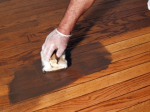
Just like homeowners with carpet need to have their carpets cleaned every so often, homeowners with hardwood flooring need to have their floors refinished to keep them looking like new. Both carpet cleaning and hardwood floor refinishing can be done by the homeowners themselves. Here are the basics for refinishing your hardwood floors on your own.
Supplies
Like any good home refurbishing, you will need to know what supplies you are going to need to get the job done. To refinish your hardwood floors you will need a walk behind floor sander, as well as a handheld power edge sander, dust mask, eye protection, ear protection, sandpaper for the floor sanders, wood putty, a shop vacuum, tack cloth, and the type of finish you want for your floor. Once you have all your supplies, remove all furniture from the room that the floor will be refinished.
Prepping
To begin the refinishing process, you will need to sand away the old finish using the walk behind sander for the main areas of the floor. Use a handheld power edge sander along the walls and in corners. Be sure to use both sanders properly and with the correct type of sand paper for each machine.
When finished sanding, go over any nicks or cracks with your wood putty and re-sand the floor once the putty has dried. Then, using a damp cloth and shop vacuum, remove all the dust from the floors, walls, and molding.
Next, wipe the floor with your tack cloths to ensure all the dust was removed from the floor. You don’t want to have dust embedded in your newly refinished floor.
Refinishing The Floor
Now that the floor’s old finish has been removed and the floors are prepped to receive a new finish, lay the desired type of finish with a sheepskin applicator. Apply the stain evenly and only use enough to cover the floor, excess stain results in ugly spots once dried. You’ll need to do three coats, allowing time to dry between coats. Dust and use the tack cloth between coats of stain to avoid a rough floor when finished.
Wait at least 24 hours before replacing any moved furniture back onto the floor.
Finish Types
There are three types of finish to choose from, each with their own pros and cons.
Polyurethane finish is either oil or water based and comes in different degrees of luster with a plastic like look after drying. Excellent for high traffic and high moisture areas, polyurethane finish tends to darken or yellow wood and is difficult to spot repair and nicks or gouges that may occur.
Varnish finish comes in a variety of luster ranging from matte to glossy. While easy to spot repair, varnish tends to darken with age.
Penetrating sealer finish is a natural looking finish that brings out the natural grain of the wood. It is the easiest of the three finish types but is also the least durable. Penetrating sealer does offer good protection though, especially when waxed.
Justin runs a small hardwood and laminate shop, Flooring HQ Store. He loves to share his knowledge about all of the flooring and home improvement options available on the market today.
